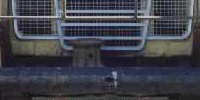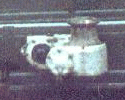Winches.
STILL UNDER CONSTRUCTION.
Contents of this page:
NB. Winching is potentially dangerous.
Steel cable stretches and it can snap.
When it snaps it is quite capable of lashing anything
nearbye and inflicting serious injury or death.
Never step over a taut winch cable!
Use good equipment, be careful, wear gloves and keep spectators well away.
The capstan winch is driven continuously when in use.
A couple of turns are made around the capstan with the rope.
Control is by applying more or less tension to the tail of the rope.
The rope is usually hemp or synthetic, not wire.
Most Land-Rover capstan winches have a 8 (is it 8? 12?) sided capstan,
although some are smooth.
The capstan winch can pull at angles to the side that would be difficult
for a drum winch to manage.
It requires two people to use the winch to self-recover a vehicle.
 Front capstan winch.
Front capstan winch.
The winch is driven from the crankshaft pulley on the front of the engine.
A dog clutch engages / disengages drive.
The starting-handle can be passed down the drive shaft,
so you can still crank the engine by hand.
 Rear capstan winch (rare).
Rear capstan winch (rare).
- photo by Leith Howie
(see the home pages).
The winch is driven by the rear transfer-case PTO.
A power take-off (PTO) can be fitted to a Land-Rover transmission.
The usual PTO replaces the cover and rear bearing for the
gearbox output shaft in the transfer case.
A shaft can take power direct from the PTO to a rear-mounted winch.
More commonly, a small gearbox takes the drive sideways
so that a shaft can carry it forwards around the gearbox and engine
to a front-mounted winch.
A PTO winch is excellent for sustained winching as
the engine has power to spare.
On the other hand, the winch only operates if the engine is running
(although some PTO winches do come with a handle for manual operation).
The main gearbox can be used to give 4 winching speeds.
The transfer-case is put in neutral for static winching,
but the wheels can be left turning to assist self-recovery.
A less common PTO fits under the transfer case.
The 101 FC side-winder winch uses this kind of PTO.
An electric winch is driven by a powerful electric motor
through a gear-train (epicyclic or worm) giving a reduction
of hundreds-to-one.
It can be used when the car's engine is not running,
but not for long periods as the winch can draw hundreds of amps.
It is recommended that a dual battery system be installed with
an electric winch and that the car engine be kept running
when winching if possible.
Electric winches wind-in at quite slow speeds, especially under
heavy load, and heat up rapidly;
PTO winches are more viable for sustained winching.
An hydraulic winch gives the fine control of an electric winch
with the endurance of a PTO winch.
(It can also give new meaning to `oil leak'.)
A hydraulic pump is driven from the transfer case PTO.
The winch is driven by a hydraulic motor.
Hydraulic winches are usually of the drum type, front or rear mounted.
There are also portable hydraulic winches made for use with
Land-Rovers that can be operated a short distance from the vehicle.
- Helper Winch,
410 S Main St, PO Box 968, Torrington, WY 82240, USA
tel: (307) 532-7622
- This info may be a bit out of date.. June 1989 issue of "Peterson's 4
wheel and Off Road" magazine had a list of various winches. They show a
self contained unit called the "Helper Winch" Looks like a winch with a
a chain saw on the back! Supposed to pull 8000 lbs.
- Michael Loiodice (landrover@delphi.com) [7/'95]
- Tirfor, hand winch.
Copyright ©
L. Allison / 1995
 Front capstan winch.
Front capstan winch.
 Front capstan winch.
Front capstan winch.
 Rear capstan winch (rare).
Rear capstan winch (rare).